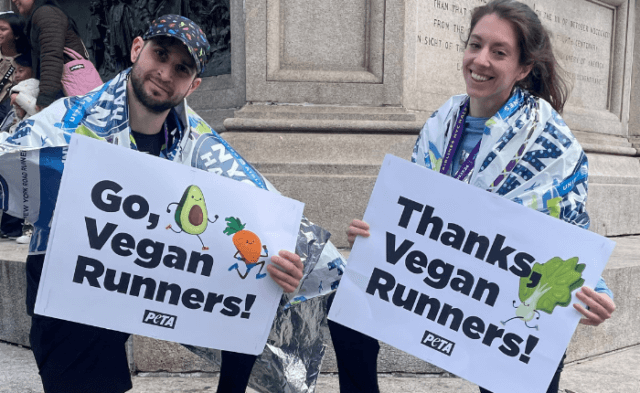By Elisa Allen, director of PETA UK
Sustainability is the fashion buzzword of 2019–with designers and retailers everywhere pledging to do more to protect the planet.
Yet somehow, animal leather is still being used in allegedly “sustainable” and “eco-friendly” collections–and this does the ethical fashion movement a big disservice. The leather industry–like other forms of animal agriculture–is responsible for serious, far-reaching environmental damage.
Turning animal skins into leather requires the use of dozens of chemicals, including highly toxic mineral salts, formaldehyde, coal-tar derivatives, and various oils, dyes, and finishes, some of which are cyanide-based. Tannery run-off contains large quantities of pollutants, such as lime sludge, sulfides, and acids.
Pollution
Tanneries are far from the only problem with leather. The 2017 Kering Environmental Profit & Loss report found that 93 percent of all the environmental damage caused by leather occurs even before the tanning stage, while the 2017 Pulse of the Fashion Industry report ranks it as the most polluting material in fashion.
Indeed, animals on factory farms produce vast amounts of greenhouse gases and 130 times as much excrement as the entire human population–without the benefit of waste-treatment plants.
Farming animals for their skin or flesh also requires massive amounts of water and grain, both of which are scarce in much of the world, and 80 percent of all deforestation in the Amazon is linked to cattle ranching.
More than a billion animals are killed for the leather trade every year. Almost all leather–even if it’s labeled, “Made in Italy” or “Made in France”–originates in Bangladesh, China, or India, where animal welfare laws either are non-existent or go unenforced.
In India, the slaughter of cows is legal in only three states, so animals may be forced to walk hundreds of miles on “death marches”, during which many collapse and die by the side of the road out of sheer exhaustion. When the survivors arrive at the abattoir, their throats are cut while they’re still conscious.
Toxic chemicals
In China, the world’s leading exporter of leather, an estimated two million cats and dogs are killed each year for their skin.
A PETA exposé shows a processing-plant owner explaining that the facility identifies items made out of dog skin, which are exported around the globe, as “lambskin”. If you buy leather, there’s almost no way, short of conducting a DNA test, to tell what–or rather, whom–you’re wearing.
Leather production also harms human health. People who work in or live near tanneries suffer as a result of exposure to the toxic chemicals that are used to process and dye animal hides. The US Centers for Disease Control and Prevention found that the incidence of leukemia among residents near one US tannery was five times the national average.
Arsenic, a common tannery chemical, has long been associated with lung cancer in workers who are exposed to it on a regular basis. Studies of tannery workers in Italy found cancer risks “between 20 percent and 50 percent above those expected”, while in developing nations where the industry is poorly regulated, the figures are even more alarming. In certain areas of Bangladesh, 90 percent of leather workers die before the age of 50.
Innovative alternatives
But there is hope. Vegan materials crafted from natural, eco-friendly resources such as mushrooms, pineapples, cork, and apples are gaining in popularity with designers and consumers.
The launch of Vegea, or “wine leather”–made with grape residue from the Italian winemaking industry–made waves in the fabric world, earning it H&M’s Global Change Award in 2017.
Last year, Peruvian brand Le Qara won the same award for its vegan leather derived from flowers and fruits. And Piñatex, Ananas Anam’s pineapple leather, is rapidly becoming a household name, thanks to its use in H&M’s Conscious Exclusive collection and in ranges by other brands, like Hugo Boss.
High-fashion events like Helsinki Fashion Week are banning leather from their catwalks, and Stella McCartney, Bruno Pieters, Vika Gazinskaya, and Faustine Steinmetz are among the top designers who have sworn off the use of skins in their collections. Even the likes of Givenchy and Versus Versace have prominently promoted vegan “eco-leather” items in order to attract ethically aware millennial consumers.
Minimizing impact
The vegan leather market is predicted to be worth $85 billion by 2025–and in the long run, the practice of raising and slaughtering animals for leather is likely to be made obsolete by the arrival of lab-grown leather, which is currently being developed by US-based company Modern Meadow.
Its “bio-leather”, Zoa, can be manufactured to look similar to cow leather or exotic skins–but without using any animals. This innovation will allow designers to use animal leather without harming living, feeling beings and with less impact on the environment.
Truly sustainable fashion seeks to minimize its impact on the natural world–and leather production is one of fashion’s biggest crimes against the living planet.
For brands to be able to proclaim their products “sustainable” with any credibility, they must distance themselves from animal skins and embrace natural, ethically produced vegan fabrics.





